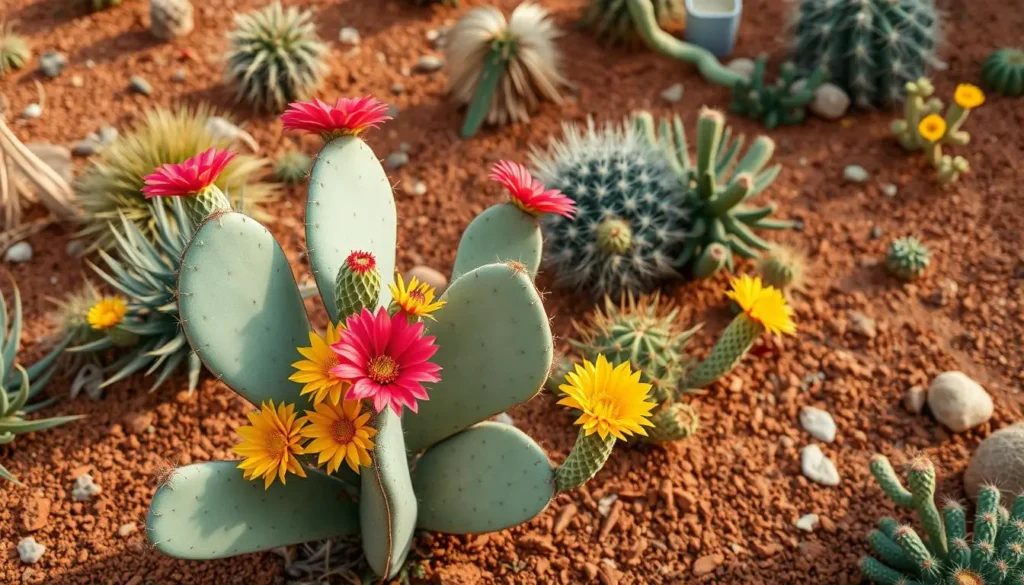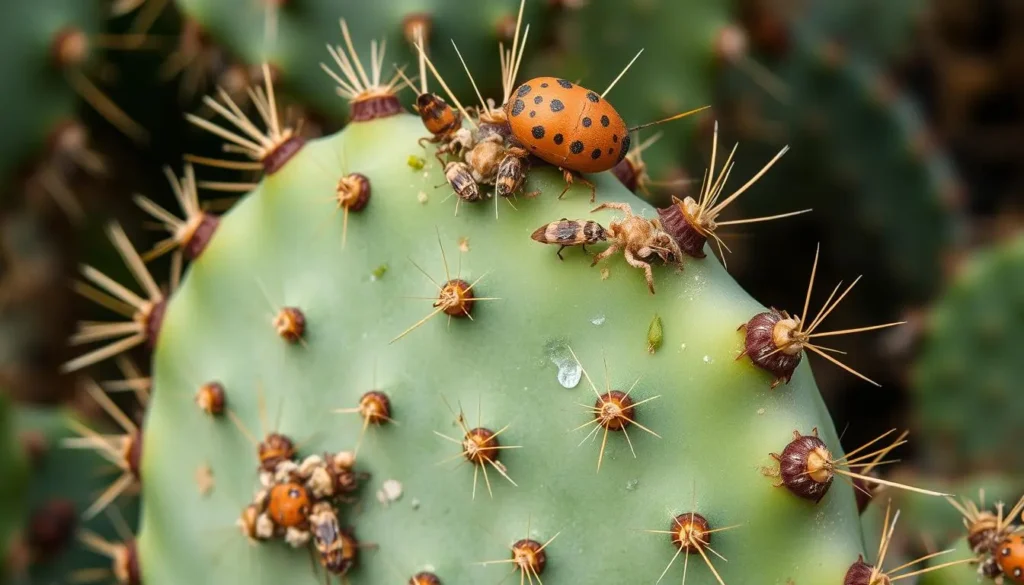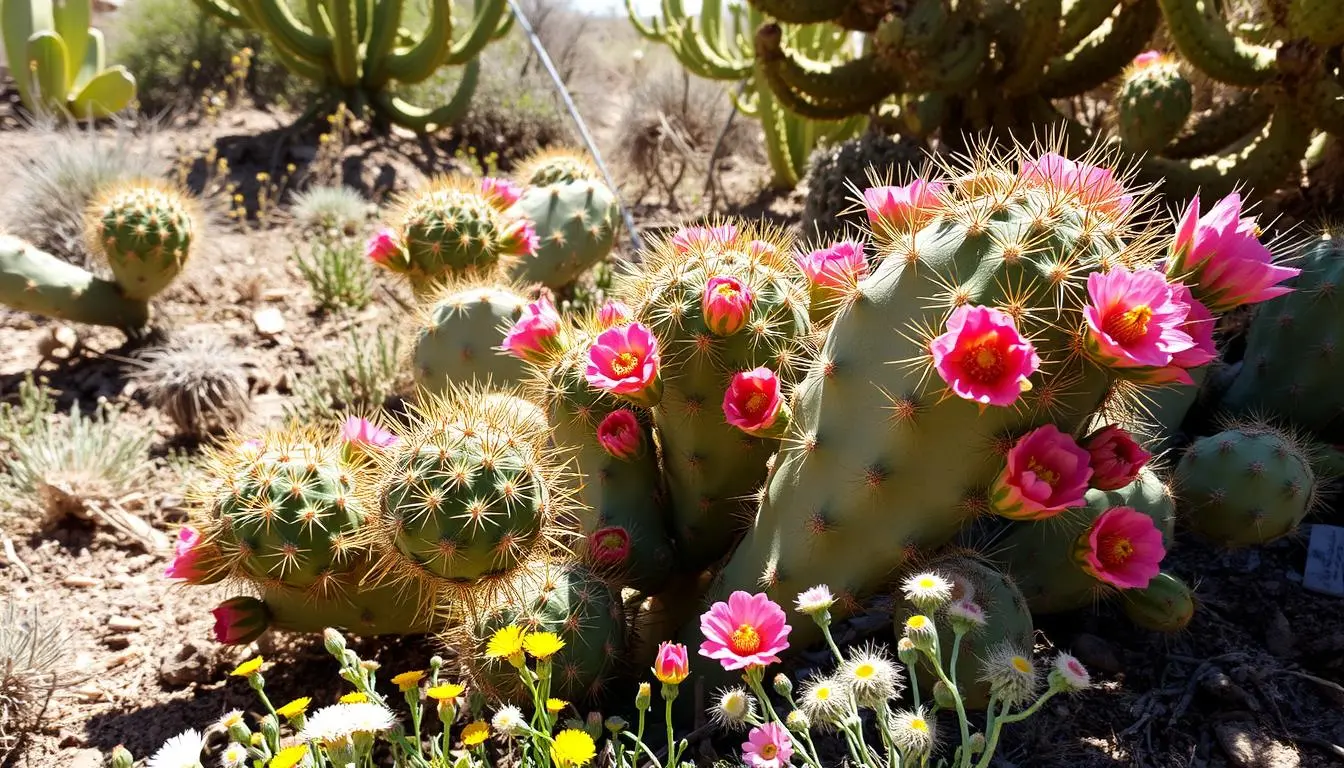I’ve always been fascinated by prickly pear cacti. These desert plants are hardy and resilient. They have vibrant blooms and paddles that seem to defy harsh conditions.
Many people want to grow their own prickly pear oasis. They want to see the magic in their backyard.
In this guide, we’ll explore prickly pear cacti. We’ll look at different species and varieties. We’ll also learn about their growth patterns and how to grow them successfully.
This article is for both seasoned gardeners and newcomers. It will help you turn your outdoor space into a prickly pear paradise.
Table of Contents
Understanding Prickly Pear Cactus: Species and Varieties
The prickly pear cactus, or opuntia, is a diverse and fascinating genus. It has a wide range of species and varieties. These resilient succulents offer a wealth of opportunities for gardeners and culinary enthusiasts alike.
Common Opuntia Varieties for Home Gardens
Some popular opuntia species for home gardens include the Opuntia ficus-indica. It’s known for its large, juicy cactus fruit. The Opuntia microdasys, or “bunny ears” cactus, is also common. Other varieties include the Opuntia humifusa, Opuntia engelmannii, and Opuntia basilaris.
Native Habitats and Growth Patterns
Prickly pear cacti are native to the Americas. They range from Canada to South America. These hardy plants thrive in arid and semi-arid climates.
They adapt to various soil types and growing conditions. Some species, like the nopales, grow low to the ground. Others, like the Opuntia ficus-indica, can grow into large, tree-like specimens.
Identifying Edible vs. Ornamental Types
- Edible opuntia varieties have larger, juicier pads and fruits. They’re great for cooking.
- Ornamental types have unique colors, shapes, or spination patterns. They’re perfect for landscaping and decoration.
Knowing the differences between these varieties helps you choose the right prickly pear cactus. Whether you want to add color to your garden or harvest delicious cactus fruit for your kitchen.
Essential Growing Requirements for Prickly Pear Cactus
To grow a paddle cactus or cactus pear well, you need to know their special needs. They require the right soil, light, and temperature to stay healthy and grow strong.
These cacti love soil that drains well, like sandy or rocky ground. The soil’s pH should be between 6.0 and 7.0. This helps them grow well in dry conditions.
When it comes to light, they need full sun. They love the warmth and brightness. Make sure they get at least 6 hours of direct sunlight a day. This helps them grow colorful and strong.
Temperature is also important. Paddle cacti and cactus pears can handle a lot of heat and some cold. But, they don’t like cold for too long. Keep them safe during winter to avoid damage.
“The prickly pear cactus is a true survivor, adapted to thrive in some of the harshest environments on Earth.”
By knowing and meeting these needs, gardeners can make a great home for these plants. They add a desert touch to any outdoor area.
Soil Preparation and Planting Techniques
Soil is the foundation for growing prickly pear cactus. The right soil mix is crucial for a thriving garden. We’ll look at the best soil, planting depth, and spacing. We’ll also compare growing in containers versus in the ground.
Best Soil Mixtures for Optimal Growth
Prickly pear cacti need well-draining, sandy soil. Mix potting soil with perlite and coarse sand or gravel. This mix ensures good air and water flow, preventing root rot. Keep the soil pH between 6.0 and 7.5 for best growth.
Proper Planting Depth and Spacing
Plant the cactus pad or cutting 2-4 inches deep. Make sure at least one-third of the pad is buried. This gives the plant a strong base. Space plants 2-3 feet apart to let them grow.
Container vs. Ground Planting
- Container Planting: Pots let you move plants indoors in bad weather. Make sure the pot has drainage holes to avoid waterlogging.
- Ground Planting: Growing plants in the ground lets them spread and develop deep roots. It’s best for warm climates with good drainage.
Choose the right method for your garden. Proper soil and planting are key for your prickly pear cactus’s health.
Watering and Humidity Management
Proper watering is key for your prickly pear cactus (Opuntia). These plants need the right amount of moisture to grow well. Too much water can cause root rot, while too little can stress the plant.
To water your Opuntia, give it about 0.5 cups of water every 12 days when it’s growing. Change this based on your area’s weather and the soil’s dryness. Make sure the soil dries a bit before you water again to avoid too much water.
- Check the soil’s surface – if it’s dry, it’s time to water.
- Water the soil directly, avoiding the plant’s pads or stems.
- Make sure the water fully soaks the soil and drains out the pot’s bottom.
Keeping the right humidity is also important for your prickly pear cactus. These plants love dry air. Try to keep the humidity around the plant below 50%.
By following these tips, your Opuntia will thrive. It will show off its vibrant pads and maybe even colorful blooms.
Light Requirements and Temperature Tolerance
Prickly pear cactus, also known as the indian fig opuntia or cactus pear, is a hardy plant. It does well in different light and temperature conditions. Knowing the best sun and temperature for these succulents is crucial for their health.
Optimal Sun Exposure Times
The indian fig opuntia needs lots of sunlight to thrive. It does best with at least 6 hours of direct sunlight daily. The ideal is 8-10 hours. A sunny spot for your cactus pear ensures it gets the sunlight it needs.
Seasonal Temperature Considerations
Prickly pear cacti can handle a wide range of temperatures. This makes them popular in many gardens. In warm months, they like temperatures between 70-90°F. They can also handle cooler temps down to about 40°F.
But, they should avoid freezing weather or frost. This can cause damage.
Protection from Extreme Weather
- Bring potted cactus pears indoors or into a greenhouse during cold snaps to shield them from frost and freezing temperatures.
- For in-ground plants, provide an insulating layer of mulch around the base to help regulate soil temperatures.
- Consider using a cold frame or lightweight fabric cover to create a barrier against harsh winter winds and precipitation.
Understanding your prickly pear cactus’s light and temperature needs helps it thrive in your garden.
Fertilizing and Feeding Schedule
To keep your prickly pear cactus (nopales) healthy, you need a good fertilizing plan. These plants have special needs for nutrients. This ensures they grow well, stay colorful, and produce lots of fruit.
Here are some tips for fertilizing your nopales:
- Balanced Fertilizer Blend: Pick a fertilizer made for cacti or succulents. It should have nitrogen, phosphorus, and potassium. This mix helps your plant grow without getting too much of any one thing.
- Slow-Release Formulation: Go for a slow-release fertilizer. It gives nutrients slowly, like the desert does naturally.
- Timing and Frequency: Start fertilizing in early spring when your cactus wakes up. Then, fertilize every 6-8 weeks during the growing season. Don’t fertilize in winter when it’s resting.
Remember, don’t overdo it with the fertilizer. Too much can harm your plant. Always follow the instructions and adjust as needed for your environment.
“Proper fertilization is the key to unlocking the true potential of your prickly pear cactus, allowing it to thrive and reward you with an abundant harvest of delicious nopales.”

With a balanced and timely fertilizing plan, your nopales will grow strong and colorful. They’ll also give you a big harvest of tasty paddle cactus fruits.
Propagation Methods and Tips
Expanding your tuna garden with prickly pear cacti is simple once you learn how to propagate. It’s all about knowing the right pad cutting techniques, tracking root growth, and avoiding mistakes. Let’s explore the secrets to growing your cactus collection.
Pad Cutting Techniques
To start, pick a healthy pad from your cactus. Use a sharp, sterilized knife to cut it. Make sure to leave a bit of stem on the pad for better rooting. Let the cut pad dry for a few days before planting.
Root Development Timeline
- Within 2-4 weeks, you should see the first signs of root development.
- Over the next 4-6 weeks, the roots will continue to grow and establish themselves.
- After 8-12 weeks, the newly propagated pad should be ready for transplanting into its permanent home.
Common Propagation Mistakes
- Cutting the pad too close to the stem, which can lead to rot and poor rooting.
- Failing to allow the cut pad to dry and callus over before planting.
- Overwatering the newly propagated pad, which can cause rot and hinder root growth.
- Planting the pad too deep, which can also contribute to rot and stunted growth.
Mastering these techniques and avoiding common mistakes will help you grow your tuna garden with thriving prickly pear cacti. Happy growing!
Common Pests, Diseases, and Solutions
Keeping a cactus garden healthy means watching out for pests and diseases. Your cactus fruit and nopal plants face many challenges. We’ll look at common problems and how to prevent and treat them.
The cactus bug, Chelinidea vittiger aequoris, is a big problem for prickly pear cacti. These bugs eat the plant’s pads, causing damage and weakening it. Check your plants often and remove bugs by hand.
- Fungal diseases like powdery mildew and root rot can harm cactus fruit and nopal plants. Make sure the soil drains well and there’s good air flow.
- Scale insects and mealybugs can also harm your cacti. Use insecticidal soaps or neem oil to fight these pests.
By being careful and quick to act, you can keep your prickly pear cactus garden healthy and beautiful. With the right care, your cactus fruit and nopal plants will do well for many years.

Conclusion
Growing prickly pear cacti, also known as Opuntia, is a rewarding journey. You’ve learned about the different species and their habitats. This guide has given you the knowledge to grow a thriving prickly pear cactus garden.
Success depends on meeting the needs of your Opuntia varieties. Whether they’re edible or ornamental, the right soil, planting depth, and spacing are key. Also, proper watering and lighting are crucial for their growth.
Start your prickly pear cactus growing adventure with excitement. These succulents are resilient and adaptable. With patience and attention to detail, you can create a beautiful, low-maintenance garden. Enjoy the journey and watch your prickly pear cacti thrive.

